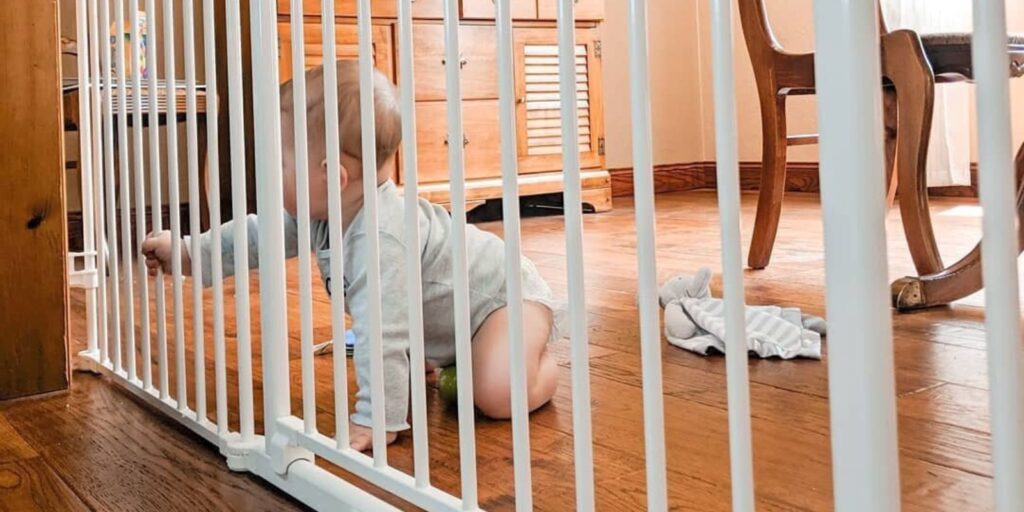Baby Proofing 101: A Checklist for Every Room
If you’re a first time parent, you may be surveying your home and nervously thinking, “Is it just me, or does this room have sixty-three outlets?” While the idea of baby proofing your home may feel overwhelming, if you take it room-by-room, it’s a much easier (and less anxiety provoking) task.
Baby Proofing the Living + Multi Purpose Rooms
Real world parent tip: Using a playpen or setting up a gated play area in your living room (or any space where your family spends a lot of time) creates a safe space that will free you up to get household chores done—doomscroll—whatever suits your mood.
- Install UL listed carbon monoxide and smoke detectors on every level of your home and/or in hallways outside of bedrooms. Make sure to check batteries annually.
- Purchase a fire extinguisher and learn how to use it.
- Have a well-stocked first aid kit on hand that’s easy to find in an emergency, and make sure all caretakers know where it’s stored.
- Have address numbers that are easily read from the street on the exterior of your house.
- Set your water heater at a maximum of 120° Fahrenheit (48° Celsius).
- If your home was built prior to 1978, get any flaking paint removed or sealed by a professional. Paint in older homes may contain lead, and is dangerous for babies or toddlers to ingest.
- Have emergency contact info displayed, including numbers for your pediatrician and poison control.
- Mount heavy furniture and TVs with wall-mount kits to prevent accidental tip-overs.
- Put grippy non-slip pads under your rugs.
- Block any outlets with furniture or use outlet covers, and make sure any electrical cords and extension cords are out of your baby’s reach.
- Install fireplace screens.
- Replace any blinds with long cords with cordless options.
- Cover furniture edges and corners with edge guards and padding.
- Latch or lock any doors, cabinets, or cupboards.
- Store purses, bags, and backpacks out of reach.
- Install baby gates at the top and bottom of staircases.
Baby Proofing the Kitchen
Real world parent tip: If your crawling baby or walking toddler is going to be joining you for meal prep, consider making one bottom cabinet accessible and baby-safe. Stash toys, measuring cups, plastic storage containers, or multi-sensory objects so your little one can entertain themselves. Just make sure nothing is a choking hazard (if it’s too big to fit inside a toilet paper tube, it’s safe for your baby).
- Cook on your stove’s back burners when possible.
- Make sure knives and cleaning products are securely locked, ideally in a spot that’s out of your baby’s reach.
- Keep glassware and dishware out of your baby’s reach.
- Latch or lock your refrigerator and garbage can.
- Install covers on stove knobs.
- Latch or lock your oven.
- Remove any tablecloths.
- Unplug and store any electrical items when not in use (toasters, blenders, etc.).
- Keep the edges of your countertops and tables clear, so your baby can’t reach up and accidentally pull anything down on themselves.
Baby Proofing the Bathroom
Real world parent tip: There are a lot of spots for your little one to get into serious trouble in a bathroom, so making sure the door is shut and locked (with a latch or door knob guard) is your safest bet.
- Install an exterior door lock.
- Lock your toilet seat, as well as drawers and cabinets.
- Keep electrical appliances, like hair dryers, out of reach.
- Move trash cans out of reach, or keep them in a locked cabinet.
- Add a non-skid mat to your tub.
- Always keep medications, cosmetics, toiletries, mouthwash, and toothpaste locked and out of reach.
Baby Proofing the Nursery
Real world parent tip: If you’re changing or dressing your little one on a raised surface, never walk away, even for a moment. Keeping one hand on your baby at all times is an easy way to prevent an accidental, sleep deprivation fueled, slip-up.
- Remove any bedding(including pillows, bumpers, comforters, sheets, or blankets) and any toy from your baby’s sleep environment, whether that is a crib or bassinet. A bare crib is the safest crib.
- Make sure your crib mattress is snug against the rails and walls of the crib, without any gaps.
- The crib shouldn’t be near any windows, other pieces of furniture, decor (including anything hung on the walls, lamps, or electrical cords.
- Store toys in open boxes, so little fingers can’t get pinched by lids.
- Keep wipes and diapering essentials out of your baby’s reach while changing.
- If you’re painting your nursery, try to finish your project at least two months before your due date so you don’t have to worry about exposing your newborn to potentially harmful fumes. Use a low VOC (Volatile Organic Compounds) paint if possible.
More Baby Proofing Resources
Safe Kids Worldwide and Childproofing Experts are excellent resources for more baby proofing tips, and even provide baby proofing services to parents.
Finding What’s Right for You
Albee Baby is the oldest family-owned specialty baby shop in the US, and we pride ourselves on providing our customers with the best assortment of baby products anywhere, at fair prices, always. We’re committed to being an inclusive resource for parents, and hope you’re feeling empowered to find the right car seat for your family. Still have questions? Feel free to contact our baby gear experts at 877.692.5233 or by email at [email protected].

